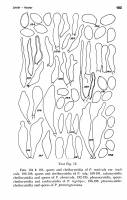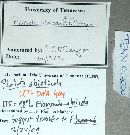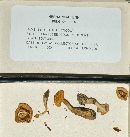
|
|
|
|
Family: Strophariaceae
|
Smith, AH & LR Hesler (1968) The North American Species of Pholiota. Hafner Publishing Company: New York, NY. 87. Pholiota abieticola sp. nov. Illustrations: Text figs. 189-191. Pileus 2.5-4 cm latus, convexus, subviscidus, glaber, ochraceus. Lamellae adnatae demum subdecurrentes, pallide luteae, confertae, latae. Stipes 3-5 cm longus, 5-8 mm crassus, clavatus, siccus. Velum fibrillosum. Sporae 7-9 (10) x 4.5-5.5 (6) µ. Pleurocystidia desunt. Cheilocystidia clavata. Caulocystidia 30-80 (100) x 4-7 µ. Specimen typicum in Herb. Univ. of Tenn. conservatum est; legit G.S.M.N.P., 14 Sept. 1941. Hesler 1400. Pileus 2.5-4 cm broad, convex, not fully expanding, viscid, soon dry, glabrous, ochraceous. Context yellow; odor and taste mild. Lamellae adnate to subdecurrent, pale yellow, finally brown, close, rather broad. Stipe 3-5 cm long, 5-8 mm thick, clavate-bulbous, dry concolorous. Veil arachnoid, white, copious, leaving an evanescent ring. Spores 7-9 (10) x 4.5-5.5 (6) µ, elliptic to oval in face view, in profile elliptic to obscurely inequilateral, smooth, tawny in KOH but on standing become paler and more ochraceous, in Melzer's reagent slowly becoming dark reddish tawny, wall (as measured in Melzer's reagent) 0.6-0.8 (1) µ thick, as measured in KOH (after mount stood for 2 hours or more) 1-1.8 µ thick, apical pore evident and in KOH mounts the apex obscurely truncated in some. Basidia 4-spored, subcylindric to narrowly clavate, 26-30 x 6-7.5 µ, yellowish in Melzer's reagent, when first revived in KOH near lemon-yellow but fading to near hyaline. Pleurocystidia absent or present as contorted basidia (same size but more irregular in shape), irregular in occurrence. Cheilocystidia present merely as basidioles (edge seen with mostly fertile basidia). Caulocystidia slender, 30-80 (100) x 4-7 µ, flexuous-elongate to almost setiform, walls thickened slightly and ochraceous in KOH, smooth. Gill trama of parallel thin-walled, non-gelatinous hyphae lemon-yellow to pale ochraceous in KOH, cells short and much inflated in central part, narrow to the cellular non-gelatinous inconspicuous subhymenium. No incrustations seen. Pileus cutis a gelatinous pellicle of narrow (2-4.5 µ) incrusted but nearly hyaline interwoven hyphae, collapsing, image not sharp (walls gelatinous); hypodermial area of floccose hyphae 4-9 µ diam. with tawny incrustations as revived in KOH (mostly as bands). Context hyphae inflated to 8-15 µ, thin-walled and yellowish to hyaline in KOH. Clamp connections present. All hyphae inamyloid. Habit, Habitat, and Distribution: On dead fir (Abies), North Carolina, September, Hesler 1400, type. Observations: This is a distinctive species on the basis of the thick-walled spores, lack of pleurocystidia (for all practical purposes) and the peculiar caulocystidia. It is clearly in the P. alnicola-malicola group. Here it's distinguishing features are the incrusted cuticular hyphae, the long flexuous often almost setiform caulocystidia with yellow walls in KOH, and lack of a distinctive odor or taste. In KOH the spores of P. abieticola are almost identical in color with those of P. malicola: a dark yellow brown, but in Melzer's both become somewhat dextrinoid (reddish tawny). Both have spore walls that swell appreciably in 2% KOH. |










